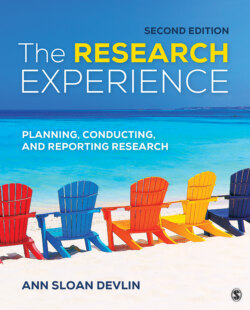Читать книгу The Research Experience - Ann Sloan Devlin - Страница 115
What Research Can Tell You: The Continuum of Certainty
ОглавлениеThe degree of control you exercise in conducting your research is usually related to the level of certainty you can have in your results—greater control is related to greater certainty. On one end of the research continuum, we do not manipulate any variable; if we want to quantify people’s answers (i.e., quantitative approaches), we typically ask people to answer questions about the topic of interest on a rating scale. For example, we might ask whether there are relationships between the number of times students work out each week, their caloric intake, and their body esteem. Using measures such as rating scales with numerical values, we would be interested in the correlations or associations between variables. Nothing is manipulated. Even in this type of study, there are additional questions we can ask that will increase our confidence in the relationships we see (perhaps we should ask about height and weight, for example, which might affect the relationships).
Type II error: Failing to reject the null hypothesis when it is false.
At the other end of the continuum, we manipulate specific variables, keep everything else the same, and try to infer causality from the study (e.g., randomly assigning students to different workout schedules before measuring their caloric intake and body esteem). You can see that even in this second case, there are still a lot of other “unmeasured” variables (e.g., students’ workout schedules prior to the study or whether they are varsity athletes) we would need to assess to be confident that differences in workout schedules caused differences in caloric intake and body esteem.
